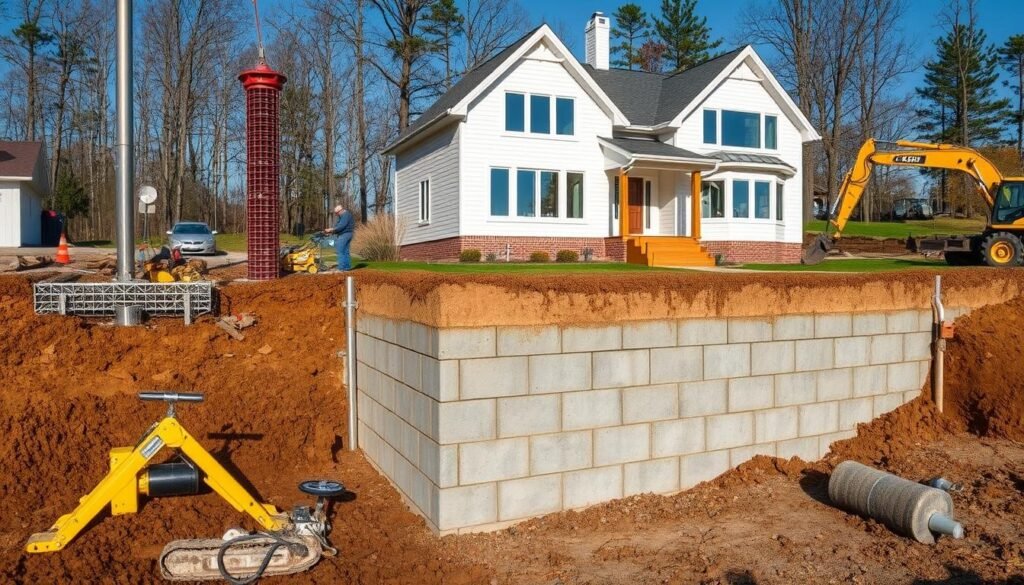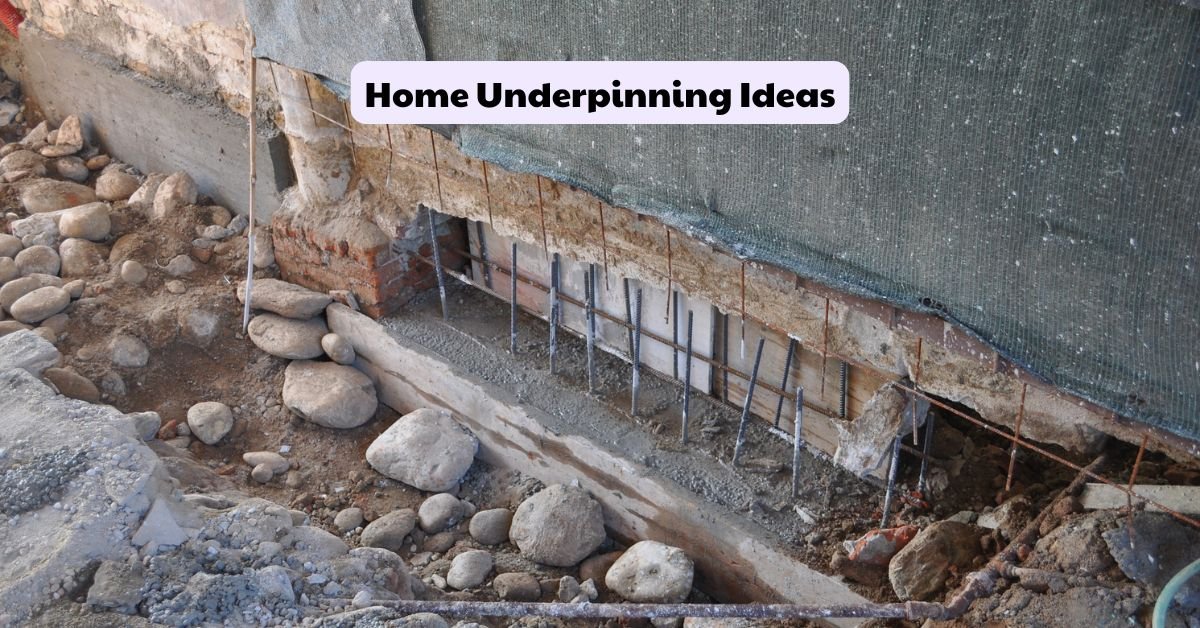Home Underpinning Ideas – Strengthen Your Foundation
Is your home showing signs of instability? Foundation strengthening through underpinning might be the solution you need. This crucial process can safeguard your property’s stability and value for years to come. Let’s explore some innovative home-underpinning ideas that can help you secure your house’s foundation.

Underpinning involves reinforcing an existing foundation to increase its depth or spread the load over a larger area. This technique is essential for homes facing structural issues or those built on unstable soil.
By implementing the proper underpinning method, you can ensure your property remains stable and maintains its value.
Key Takeaways – Home Underpinning Ideas
- Home underpinning strengthens foundations and ensures property stability
- Various underpinning techniques are available to suit different needs
- Underpinning can increase your home’s value and longevity
- Professional assessment is crucial before starting any underpinning project
- Regular maintenance post-underpinning helps preserve foundation integrity
Understanding Home Underpinning – What It Is and Why It Matters
Home underpinning is critical to fixing foundation problems. It makes the foundation stronger by adding support to your house.
Definition of Home Underpinning
Home underpinning strengthens a building’s foundation. It’s needed when the foundation can’t support the house anymore. This might mean making the foundation deeper or broader to spread the weight better.
Common Reasons for Underpinning
There are many reasons why you might need to underpin your home:
- Soil erosion or instability
- Poor initial construction
- Changes in ground conditions
- Adding extra storeys to a building
- Repairing damage from natural disasters
The Importance of a Strong Foundation
A strong foundation keeps your home safe and lasts longer. It makes sure your home:
| Benefit | Description |
| Structural Integrity | It prevents cracks, tilting, and other structural issues. |
| Property Value | Maintains or increases the value of your home |
| Safety | Protects occupants from potential hazards |
| Energy Efficiency | Reduces energy loss through foundation cracks |
Knowing about home underpinning is vital to keeping your property stable. Fixing foundation problems early stops more significant issues later. This keeps your home safe and valuable for a long time.
Signs Your Home May Need Underpinning
Spotting early signs of foundation problems can save you from expensive repairs later. If you see sure signs, your home might be telling you something important about structural issues.
Cracks in walls are often the first clue of foundation issues. Look out for diagonal cracks near doors and windows. These cracks suggest your foundation is moving unevenly.
Uneven floors are another warning sign. If your floors slope or dip, it might mean your foundation is sinking in some spots. Try placing a marble on the floor; if it rolls by itself, you could have a foundation problem.
Doors and windows that stick or won’t close right can also point to foundation movement. As your house settles, these openings can get out of line, making them hard to use.
- Gaps between walls and ceilings or floors
- Cracks in exterior brickwork or concrete
- Visible gaps around window frames or door frames
- Damp patches in lower levels of your home
If you see any of these signs, act fast. Ignoring foundation issues can lead to more significant structural problems later. A professional check can tell if underpinning is needed to fix your home and stop further damage.
“The integrity of your home’s foundation is paramount. Don’t wait until small cracks become gaping fissures.”
Not all foundation movements need quick action, but it’s wise to act early to protect your home’s structure.
Types of Home Underpinning Techniques
There are many underpinning methods for foundation repair. Each has its benefits for strengthening structures. Let’s look at the main types of home underpinning techniques.
Mass Concrete Underpinning
This method digs under the foundation and fills it with concrete. It’s great for shallow foundations in stable soil. Mass concrete underpinning gives strong stability but takes a lot of time.
Beam and Base Underpinning
Beam and base underpinning uses concrete beams to move the load to a new base. It’s good for deeper foundations and weak soil areas. This method is versatile but needs careful planning.
Mini-Piled Underpinning
Mini-piled underpinning drills small piles into the solid ground under the foundation. It’s perfect for sites with limited access and can go deep. This method is less invasive but might cost more.
Resin Injection Underpinning
This modern technique uses resin to lift and stabilise foundations. It’s fast, clean, and doesn’t disturb much. Resin injection is excellent for minor foundation problems but not for significant issues.
Choosing the proper underpinning method depends on your situation—things like soil type, building type, and damage level matter. Always talk to a professional to find the best repair technique for your home.
The Process of Home Underpinning – Step-by-Step Guide
Understanding the underpinning process is vital for homeowners looking into foundation repairs. This guide breaks down the main stages of home underpinning. It gives you an idea of what to expect in this detailed structural engineering project.
The first step is a detailed check-up by a skilled structural engineer. They examine the damage and recommend the best underpinning method for your home.
- Site preparation and safety measures
- Excavation of soil around the foundation
- Installation of temporary support structures
- Removal of damaged foundation sections
- Reinforcement placement
- Concrete pouring and curing
- Removal of temporary supports
- Soil backfilling and compaction
Excavation happens in steps to keep the building stable. Temporary supports hold up the building while work is done. Then, the damaged foundation parts are taken out, and new reinforcements are added.
After the reinforcements are set, new concrete is poured for a more substantial base. Once the concrete is complex, the temporary supports are taken away. The holes are filled with soil and packed down. This careful process makes sure your home’s foundation is stable and lasts a long time.
| Stage | Duration | Key Activities |
| Initial Assessment | 1-2 days | Structural analysis, method selection |
| Preparation | 2-3 days | Site setup, safety measures implementation |
| Excavation | 3-5 days | Soil removal, temporary support installation |
| Reinforcement | 2-4 days | Steel placement, formwork construction |
| Concrete Work | 5-7 days | Pouring, curing, support removal |
| Finishing | 2-3 days | Backfilling, compaction, site cleanup |
Costs Associated with Home Underpinning
Understanding the costs of home underpinning is vital. The price can change a lot based on many things and the method used.
Factors Influencing Underpinning Costs
The size of your home, the soil it sits on, and how much damage there is all matter. Labour and material costs in your area also play a part in the total price.
Average Cost Ranges for Different Methods
Underpinning prices vary with the method chosen. Here’s a look at average costs for some common ways:
| Method | Average Cost Range (USD) |
| Mass Concrete | $5,000 – $15,000 |
| Beam and Base | $10,000 – $25,000 |
| Mini-Piled | $15,000 – $40,000 |
| Resin Injection | $7,000 – $20,000 |
Potential Long-Term Savings
The upfront cost of underpinning might seem high, but it can save you a lot later on. Fixing foundation problems early stops bigger, more expensive repairs down the line.
“Timely foundation repairs are an investment in your home’s future, potentially saving you thousands in the long run.”
The exact cost of underpinning your home will depend on its specific needs. For the best estimate, always get a professional assessment and quote.
DIY vs Professional Underpinning – Pros and Cons
Underpinning is a crucial task in home improvement that needs careful thought. DIY underpinning might look appealing, but it’s vital to look at the pros and cons of professional foundation repair.
DIY underpinning can save money on minor repairs. It lets homeowners manage their projects and cut costs. Some people enjoy the challenge of fixing things themselves.
However, professional foundation repair brings expertise and safety. Experts know how to tackle tough underpinning jobs for lasting results. They use special tools and can handle any problems that come up.
| Aspect | DIY Underpinning | Professional Foundation Repair |
| Cost | Lower initial expenses | Higher upfront cost |
| Expertise | Limited knowledge | Extensive experience |
| Equipment | Basic tools | Specialised machinery |
| Time | Longer duration | Efficient completion |
| Safety | Potential risks | Adherence to safety standards |
The choice between DIY and professional underpinning depends on your project’s complexity and your skills. For extensive foundation repairs, it’s best to get experts to make sure your home is safe.
Home Underpinning Ideas – Innovative Approaches to Foundation Strengthening
The world of foundation repair is changing fast, with new methods and tech coming out. These new ways are making fixing foundations better and more accessible. Let’s look at some top-notch ways to strengthen your home’s base.
Eco-Friendly Underpinning Solutions
More people want to fix foundations in a green way. They are now, underpinning uses recycled stuff and things that don’t harm the planet as much. These new methods make foundations stronger and are better for the environment.
Technological Advancements in Underpinning
Smart tech is now part of fixing foundations. Systems with sensors watch how the soil and foundation move. This means you can fix problems early and avoid significant repair costs later.
Combining Underpinning with Home Improvements
Now, underpinning is being mixed with other home updates to add more value and efficiency. For instance, you could make your foundation stronger by adding underfloor heating or better drainage. This way, your home stays stable and gets more valuable and comfy.
By using these new ideas, your home’s foundation will stay solid. You’ll also get to enjoy the latest in building tech and green solutions.
Legal Considerations and Permits for Home Underpinning
Planning a home underpinning project means understanding the legal rules. These rules change with your location, so it’s vital to know the local laws. Most places need building permits for work like this, including fixing the foundation.
- Research local underpinning regulations
- Consult with a structural engineer
- Apply for necessary building permits
- Notify neighbours if required by property laws
- Obtain approval before commencing work
Not getting the proper permits can result in fines, stopping work, or even legal trouble. It’s wise to spend time understanding and following the rules to avoid these issues later.
| Document | Purpose | Typical Processing Time |
| Building Permit | Authorises structural work | 2-6 weeks |
| Soil Report | Assesses ground conditions | 1-2 weeks |
| Engineering Plans | Details underpinning method | 2-4 weeks |
Dealing with legal matters early makes the underpinning process smoother and ensures your home’s foundation is strong in structure and law.
Case Studies – Successful Home Underpinning Projects
Looking at real-life underpinning examples gives us insights into foundation repair success stories. We’ll look at three different projects that show how underpinning techniques work well.
Victorian Terrace Restoration
A row of Victorian terraces in London had major subsidence problems. Mass concrete underpinning was used to stabilise the foundations. This method was perfect for the old buildings, keeping their history while making them stable for a long time.
Modern Home Stabilisation
A modern house in Manchester was sinking because the soil wasn’t compacted well. They used resin injection underpinning, which was fast and didn’t damage the property much. This method worked well, lifting and levelling the house.
Historic Building Preservation
Restoring a 16th-century manor house in York was a big task. They used beam and base underpinning to fix foundation problems without harming the building’s history. This shows how important it is to have a custom plan for complex restoration jobs.
These examples show how underpinning can be used for different types of buildings and ages. Each project needed careful planning and doing. In the end, they made sure the buildings were safe and lasted a long time.
Maintenance Tips After Underpinning
After underpinning your home, it’s vital to keep up with foundation care. Regular checks with a pro can spot issues early. This helps your foundation last longer.
Managing moisture is crucial after underpinning. Clean gutters and ensure good drainage around your home. This stops water from gathering near the foundation, which could cause future issues. Think about getting a dehumidifier for your basement or crawl space to keep moisture levels down.
Keep an eye out for new cracks or changes in your home’s structure. Some settling is normal, but significant changes might mean underpinning issues. If you see anything worrying, get advice from a structural engineer.
Being proactive with upkeep is vital for your home’s safety. By following these tips, you’ll keep your foundation stable and secure for years to come.







